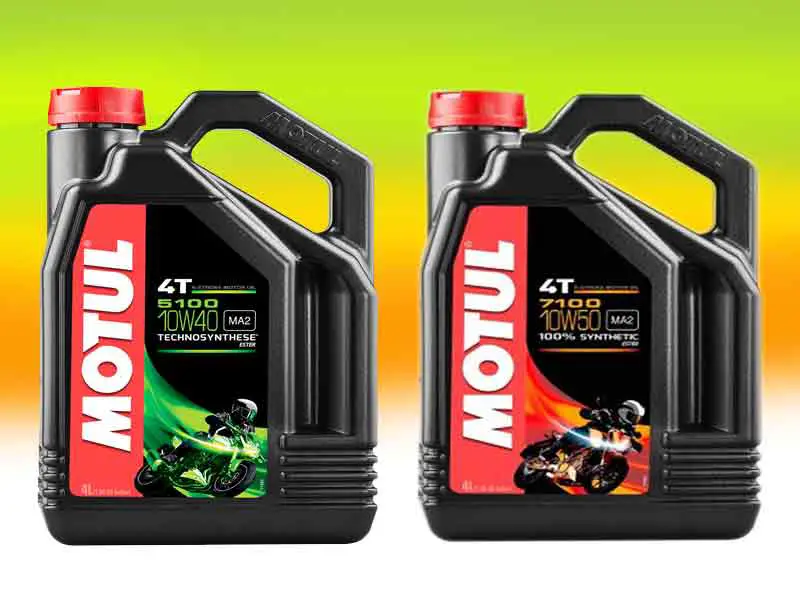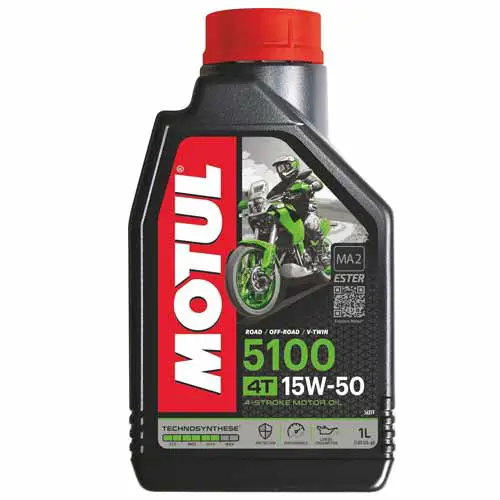Motul 5100 is semi-synthetic while its counterpart Motul 7100 is fully synthetic. Both of these are made for 4-stroke engines, mainly used in motorbikes and other vehicles.
Motul 5100 contains Technosynthese synthetic lubricant which is fortified by Ester base stock to provide anti-wear qualities and increase gear protection and lifespan. It offers improved high-temperature oil film resistance for engine durability. It has optimized phosphorus and sulfur content for improved catalytic converter working conditions.

Whereas the Motul 7100 has Ester Technology hence Ester with a low traction coefficient helps reduce engine internal friction losses and boost performance. Ester-anti-wear additive synergy and increased shear resistance for improved gear protection and life duration. It has a 100% synthetic formula for increased oil film resistance at high temperatures and speeds. The revolutionary anti-wear additives package protects the gearbox well.
Table of Contents
Motul 5100 Vs 7100


| Features | Motul 5100 | Motul 7100 |
| Application | Engine Lubricants | Engine Lubricants |
| Color | Amber | Red |
| Engine Type | 4-Stroke | 4-Stroke |
| Product Type | 5100 4T | 7100 4T |
| Quality | Technosynthese (Semi Synthetic) | 100% Synthetic |
| Product Range | Motorcycle | Motorcycle |
| Viscosity | 10W-40 | 10W-40 |
| API Standards | API SM/SL/SJ/SH/SG | API SM/SL/SJ/SH/SG |
| JASO Standards | JASO MA2 – M033MOT156 | JASO MA2 – M033MOT161 |
| Packaging | 1L Can, 2L Can, 4L Can, 5L Can, 60L Drum, 208L Drum, 1000L Container, Bulk | 1L Can, 2L Can, 4L Can, 5L Can, 60L Drum, 208L Drum, 1000L Container, Bulk |
Compatibility
Both oils are equally compatible with all Sports bikes, street and road bikes, trails, off-road bikes, and enduro that are equipped with four-stroke engines.
These 4 strokes whether having integrated gearboxes or not, wet or dry clutches, engines satisfying Euro 2, 3, 4, or 5 emission regulations are all compatible.
Some other applications include street motorcycles without catalytic converters, scooters, ATVs, and UTVs.
Affect on Catalytic Converter Performance
Zinc and phosphorous are the most often utilized anti-wear additives in engine lubricants. Their disadvantage is that they emit toxic ash, which degrades the function of the catalytic converter.
When a little quantity of engine oil leaks into the combustion chamber and burns, this ash forms. The proportion of these two compounds in engine oil impacts the amount of ash formed and, consequently, the effect on the catalytic converter.
Since the zinc and phosphorous concentrations in Motul 7100 is higher as compared to Motul 5100, their effect on the catalytic converter will be greater.
| Comparing oils (5W-30 Grade oils) | Concentrations of Zinc (ppm) | Concentrations of Phosphorus (ppm) |
| Motul 5100 4T | 1174 | 1018 |
| Motul 7100 4T | 1178 | 1043 |
Sludge Reduction
When engine oil broke apart due to high temperatures and combines with oxygen, the oxidation process begins. Then it combines with debris, contaminants, and waste to produce sludge and deposits in the engine, thickening the engine oil and causing it to flow more slowly.
Lubricant producers devised a solution by incorporating cleaning chemicals into the engine oil. Magnesium and calcium are the most often used cleaners, and their content in lubricating oil determines its cleaning capabilities.
The cleaning agent’s concentrations in Motul 7100 are more than that of its competition, making it a more powerful motor oil for sludge and deposit. The same is also true for the Anti-foam agent silicon.
| Comparing oils (5W-30 Grade oils) | Concentrations of Sodium (ppm) | Concentrations of Magnesium (ppm) | Concentrations of Calcium (ppm) | Concentrations of Silicon (ppm) |
| Motul 5100 4T | 0 | 12 | 2174 | 7 |
| Motul 7100 4T | 1 | 12 | 2346 | 10 |
Wear Reduction
Zinc, Molybdenum, boron, and phosphorous are the most frequently utilized anti-wear additive in motor lubricants.
Their function is to build a thick lubricating layer between rotating engine components to minimize resistance and insulate them from wear.
Their quantity will decide the thickness and strength of this wear protection layer over engine parts.
Because the quantities of anti-wear chemicals in Motul 7100 are higher than its counterpart Motul 5100, their wear protecting capacity is likewise greater. Therefore, it will be preferred if one is seeking engine lubricant with superior anti-wear properties.
| Comparing Oils (5W-30 Grade oils) | Zinc Concentration (ppm) | Phosphorus Concentration (ppm) | Boron Concentration (ppm) | Molybdenum Concentration (ppm) |
| Motul 5100 4T | 1147 | 1018 | 27 | 28 |
| Motul 7100 4T | 1178 | 1043 | 1 | 30 |
Performance in Hot Weather
The thickness of engine oil is defined as its reluctance to flow. When comparing the viscosities of different engine oils, two significant characteristics to examine include kinematic viscosity and viscosity index. Kinematic viscosity is calculated by dividing engine oil viscosity by density.
The viscosity index measures the influence of temperature change on lubricant viscosity.
Motul 7100 has a greater density at 20 degrees and kinematic viscosity at 40 degrees temperatures than its competitor. We can also observe that it has a relatively lower viscosity index, indicating that its viscosity is more impacted by temperature changes. Whereas the Motul 5100 has a somewhat higher kinematic viscosity at 100-degree temperature.
| Engine Oils (15W-50) | Density @ 20° C (Kg/m3) | Kinematic Viscosity @ 40° C (cSt) | Kinematic Viscosity @ 100° C (cSt) | Viscosity Index |
| Motul 5100 4T | 0.865 | 87.6 | 13.8 | 161 |
| Motul 7100 4T | 0.859 | 88.8 | 13.5 | 154 |
Performance in Cold Weather
Lubricating oil loses its streaming characteristic under cold weather circumstances at a specific low temperature, termed the pour point temperature. Based on the pour point temperature we can conclude that both are equally capable in cold weather.
| Engine Oils (15W-50) | Pour Point Temperature (°C) |
| Motul 5100 4T | -33 |
| Motul 7100 4T | -33 |
Fuel Usage
Engine oils burn off at high temperatures dependent on two essential parameters: volatility and flashpoint. The evaporating potential of any fluid at any temperature is determined by its volatility, whereas the flash point is the temperature at which the fumes would ignite if an ignition source was present.
The drying of engine oil generates a lack of lubricating oils in the engine, which can lead to engine seizure.
Because Motul 5100 has a slightly lower flashpoint temperature than Motul 7100, it will burn out faster. As a result, under high-temperature situations, this motor oil shouldn’t be preferred over its opponent.
| Engine Oils (15W-50) | Flash point Temperature (°C) |
| Motul 5100 4T | 226 |
| Motul 7100 4T | 236 |
Comfort
JASO has developed its 4-stroke motorcycle standard, JASO T903, which is available in three grades: MA, MA1, and MA2.
Both Motul 5100 and 7100 are JASO MA2 which provides the most efficient friction levels to ensure clutch engagement in all three riding modes: starting, acceleration, and constant speed.
Oil Change frequency
Engine burning produces toxic acids that can damage engine components. Because of this, basic oil components are added to motor oils to counteract the acids. The Total Base Number (TBN) influences their neutralizing power.
Furthermore, the higher the TBN content of a lubricant, the longer it will survive in the engine and the longer the oil change interval.
According to that criterion, the Motul 7100 would outlast its opponent because its TBN is somewhat greater. As a result, the oil change interval of Motul 5100 is lower than that of its peer.
| Engine Oils (15W-50) | Total Base Number (mg KOH/g) |
| Motul 6100 Synergy | 7.5 |
| Motul 7100 4T | 8.4 |
To Conclude
- Motul 7100 is synthetic while Motul 5100 is semi-synthetic.
- Motul 7100 wear resistance and sludge removal are greater along with the impact on the catalytic converter.
- In medium-temperature situations, Motul 7100 would be a preferable choice whereas in high temperatures Motul 5100 would perform better due to a higher viscosity index.
- Motul 5100 will burn off quickly due to lower flash points.
- The Motul 5100’s oil change frequency is lower than that of its competitor.
- Motul 7100 is more expensive than its counterpart.